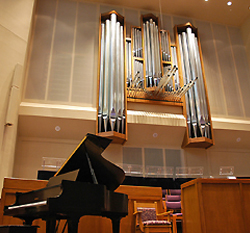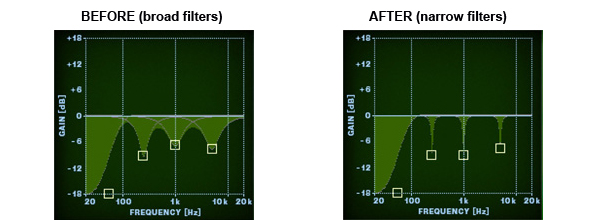
Wouldn’t it be nice if we could reduce the gain on only the narrow feedback frequencies without affecting much of the ranges just above and below them?
It is clear that we would benefit from cutting with EQ filters that are much narrower, and placed exactly on the feedback frequencies.
What is needed here is simply good parametric EQ. Some fine mixing consoles have fully parametric equalizers on each channel strip, but many do not. Some simply have fixed-frequency EQ, while others feature “semi-parametric” or “quasi-parametric” EQ.
There is a big difference. Fully parametric EQ allows us to adjust three parameters: the filter’s gain (cut or boost), the center frequency and the Q (bandwidth).
Fixed frequency EQs have a pre-selected and permanent center frequency and Q. They are somewhat useful for tonal shaping, but don’t allow the operator to adjust the frequency or bandwidth of the filter—they are far less than ideal for feedback filtering.
Still, a number of consoles employ fixed frequency EQs for the low and high filters, and then feature a semi-parametric midrange control.
But again, for notching feedback, we require control of all three filter parameters described previously.
So in that first example where we cut the high-mid frequency down, a parametric EQ would have allowed us to do this:
Note that the range of frequencies affected by this filter is considerably smaller than the original broad cut we made at the same frequency of 5 kHz.
If we use similarly narrow filters for those next ring tones (250 Hz and 1 kHz), the final result of our effort looks like this:
Big difference as compared to the original result with broader filters! So our filters are centered at exactly the same frequencies as before, but because we have set their bandwidths to be extremely narrow, we’re now only cutting the feedback points, and cutting very little of the sounds above and below.
Here are the results again, side by side, for comparison:
This improves GBF nicely and has little effect on the sound quality. This is a dramatic improvement over using medium or broad filters.
This technique requires practice. Cutting feedback frequencies with very exacting, narrow filters is a bit tedious at first, but is well worth the effort and gets easier with experience.
This practice of using parametric EQ to increase GBF is not specific to the choir example—it applies to most sound reinforcement miking applications. If there is also a need for artistic, shaping EQ adjustments, the EQ setting then becomes a careful and complex compromise—a balance of taste and required GBF.
In Summary
Any microphone in a sound reinforcement application will feedback if its gain is raised high enough. We can use proper microphone selection, directivity and placement to maximize gain-before-feedback. In some cases, we still desire more.
Once the physical arrangement is optimized, narrow EQ filters (essentially “notch filters”), achievable with parametric equalizers, can be very effective in further increasing gain-before-feedback without significantly degrading the sound quality. If the mixing console has fully parametric EQ on its channel strips, great! Just practice. If it does not, external parametric equalization may be inserted.
Very narrow cut filters must be centered exactly on the feedback frequency, which requires care to find. A broader EQ filter is not as challenging to center, and as long as it is “close,” it will help reduce feedback. But it cuts a wider range of frequencies than is actually needed for feedback control, at the cost of reduced sound quality.
Ear training, practice and the user of live visual tools such as an RTA or FFT display can improve one’s ability to quickly identify and cut a specific feedback frequency with an appropriately narrow EQ filter.
Kent Margraves began with a B.S. in Music Business and soon migrated to the other end of the spectrum with a serious passion for audio engineering. Over the past 25 years he has spent time as a staff audio director at two mega churches, worked as worship applications specialist at Sennheiser and Digidesign, and toured the world as a concert front of house engineer. Margraves currently serves the worship technology market at WAVE (wave.us) and continues to mix heavily in several notable worship environments including his home church, Elevation Church, in Charlotte, NC. His mission is simply to lead ministries in achieving their best and most un-distracted worship experience through technical excellence. His specialties are mixing techniques, teaching, and RF system optimization.



